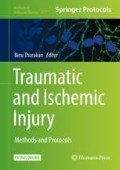Abstract
The development of acute kidney injury (AKI) is both a significant and independent prognostic factor of mortality in patients with sepsis, but its pathophysiology remains unclear. Herein, we describe an ovine model of sepsis evoked by the administration of live Escherichia coli in which there is hypotension, peripheral vasodilatation with a large increase in cardiac output; a similar hyperdynamic state to that commonly reported in humans. Interestingly, in this sheep model of sepsis, despite an increase in global kidney blood flow, there is a progressive reduction in renal function. Although renal hyperperfusion develops, renal tissue hypoxia due to redistribution of intrarenal blood flow may contribute to the pathogenesis of septic AKI. We have, therefore, developed a novel methodology to chronically implant combination probes to monitor intrarenal tissue perfusion and oxygen tension during the development of septic AKI in conscious sheep with hyperdynamic sepsis.
Access this chapter
Tax calculation will be finalised at checkout
Purchases are for personal use only
References
Mori T, Shimizu T, Tani T (2010) Septic acute renal faliure. Contrib Nephrol 166:40–46
Bagshaw SM, Uchino S, Bellomo R et al (2007) Septic acute kidney injury in critically ill patients: clinical characteristics and outcomes. Clin J Am Soc Nephrol 2:431–439
Bagshaw SM, George C, Bellomo R et al (2008) Early acute kidney injury and sepsis: a multicentre evaluation. Crit Care 12:R47–R47
Schrier RW, Wang W (2004) Acute renal failure and sepsis. N Engl J Med 351:159–169
Di Giantomasso D, May CN, Bellomo R (2003) Vital organ blood flow during hyperdynamic sepsis. Chest 124:1053–1059
Langenberg C, Wan L, Egi M et al (2006) Renal blood flow in experimental septic acute renal failure. Kidney Int 69:1996–2002
Dellinger RP, Levy M, Rhodes A et al (2013) Surviving sepsis campaign: international guidelines for management of severe sepsis and septic shock, 2012. Intensive Care Med 39:165–228
Brenner M, Schaer GL, Mallory DL et al (1990) Detection of renal blood flow abnormalities in septic and critically ill patients using a newly designed indwelling thermodilution renal vein catheter. Chest 98:170–179
Rector F, Goyal S, Rosenberg I et al (1973) Sepsis: a mechanism for vasodilation in the kidney. Ann Surg 178:222–226
Weber A, Schwieger IM, Poinsot O et al (1992) Sequential changes in renal oxygen consumption and sodium transport during hyperdynamic sepsis in sheep. Am J Physiol 262:F965–F971
Chvojka J, Sykora R, Krouzecky A et al (2008) Renal haemodynamic, microcirculatory, metabolic and histopathological responses to peritonitis-induced septic shock in pigs. Crit Care 12:R164–R164
Calzavacca P, Evans RG, Bailey M et al (2015) Long-term measurement of renal cortical and medullary tissue oxygenation and perfusion in unanesthetized sheep. Am J Physiol Regul Integr Comp Physiol 308:R832–R839
Griffiths J, Robinson S (1999) The OxyLite: a fibre-optic oxygen sensor. Br J Radiol 72:627–630
Leong CL, O’Connor PM, Eppel GA et al (2008) Measurement of renal tissue oxygen tension: systematic differences between fluorescence optode and microelectrode recordings in anaesthetized rabbits. Nephron Physiol 108:p11–p17
O’Connor P, Anderson W, Kett M et al (2007) Simultaneous measurement of pO2 and perfusion in the rabbit kidney in vivo. Adv Exp Med Biol 599:93–99
Calzavacca P, Evans RG, Bailey M et al (2015) Cortical and medullary tissue perfusion and oxygenation in experimental septic acute kidney injury. Crit Care Med 43:e431–e439
Bednarik JA, May CN (1995) Evaluation of a transit-time system for the chronic measurement of blood flow in conscious sheep. J Appl Physiol 78:524–530
Acknowledgment
This work was supported by grants from the National Health and Medical Research Council of Australia (NHMRC, 454615, 1009280, 1050672), and by funding from the Victorian Government Operational Infrastructure Support Grant. YRL was supported by a Postdoctoral Fellowship by the National Heart Foundation of Australia (NHF, 100869).
Author information
Authors and Affiliations
Corresponding author
Editor information
Editors and Affiliations
Rights and permissions
Copyright information
© 2018 Springer Science+Business Media, LLC
About this protocol
Cite this protocol
Lankadeva, Y.R., Kosaka, J., Evans, R.G., May, C.N. (2018). An Ovine Model for Studying the Pathophysiology of Septic Acute Kidney Injury. In: Tharakan, B. (eds) Traumatic and Ischemic Injury. Methods in Molecular Biology, vol 1717. Humana Press, New York, NY. https://doi.org/10.1007/978-1-4939-7526-6_16
Download citation
DOI: https://doi.org/10.1007/978-1-4939-7526-6_16
Published:
Publisher Name: Humana Press, New York, NY
Print ISBN: 978-1-4939-7524-2
Online ISBN: 978-1-4939-7526-6
eBook Packages: Springer Protocols

